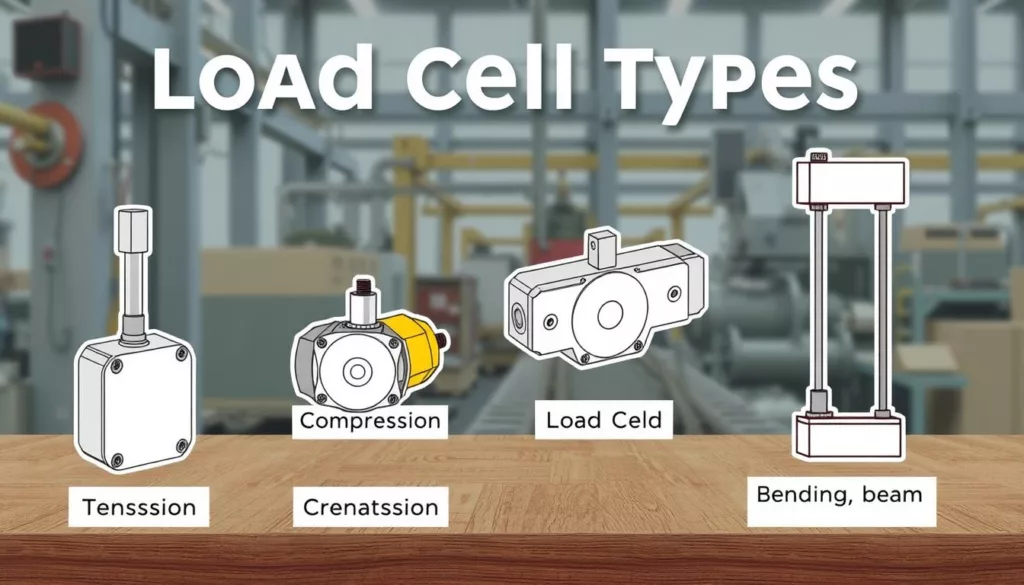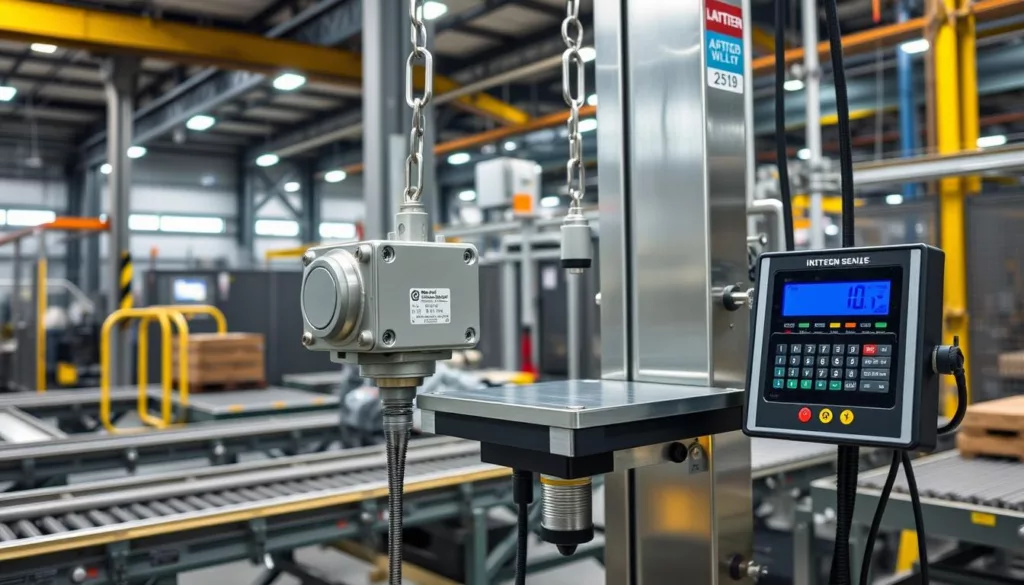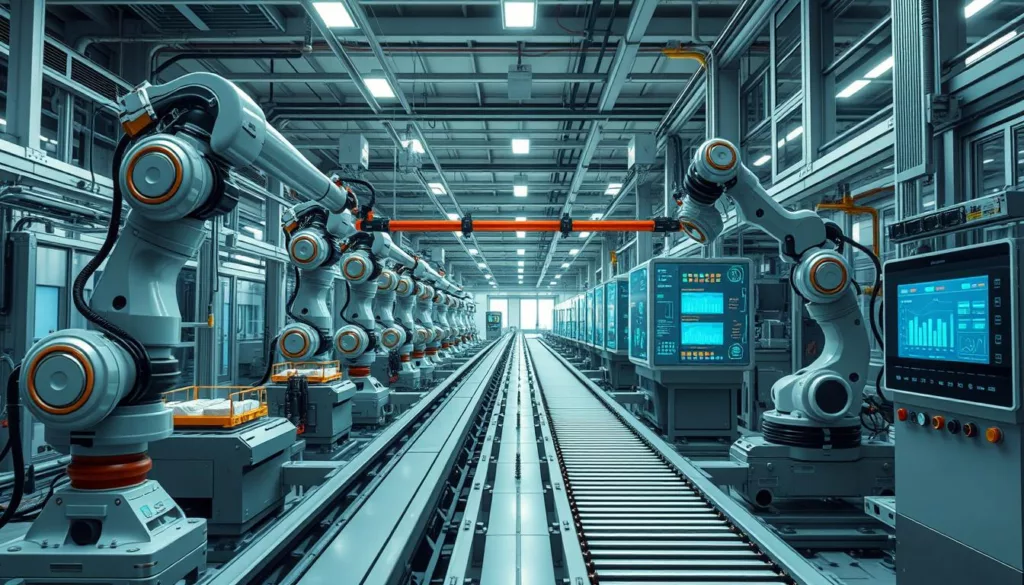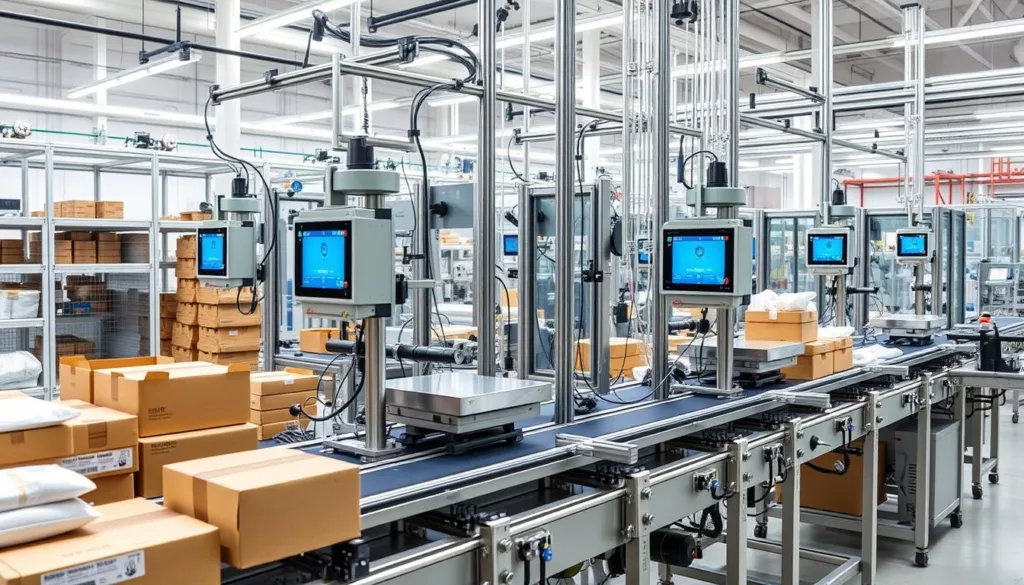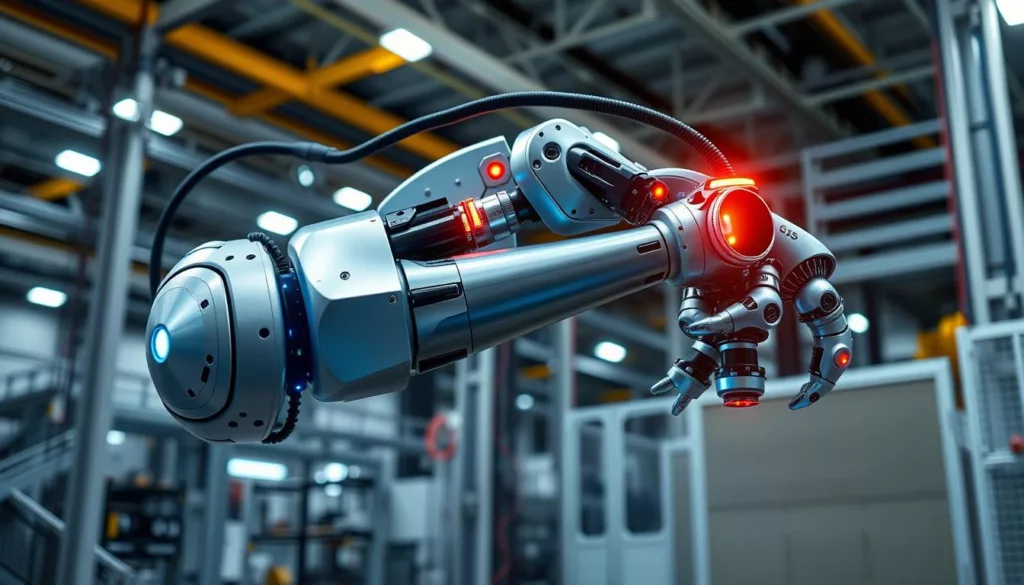In today’s fast-paced manufacturing world, load cells are more important than ever. These sensors measure force, weight, and pressure with great accuracy. They are key in many industrial uses, from improving production to ensuring product quality.
This article will look at how load cells are changing manufacturing. We’ll see how they boost efficiency, quality control, and automation in different fields. By learning about load cells, manufacturers can use them to their fullest advantage.
Key Takeaways
- Load cells are vital in modern manufacturing, helping measure force and weight accurately for many uses.
- These sensors are key in making production better, improving quality, and automating more tasks across industries.
- Knowing how load cells work and their uses is key for manufacturers wanting to boost their efficiency and consistency.
- New technologies like digital load cells and IoT integration are leading to more innovation in the field.
- Using load cells can bring big benefits, like less waste, better product quality, and more productivity for businesses.
Introduction to Load Cells and Their Importance
At the heart of any industrial weighing system is a key part: the load cell. These devices turn physical force measurement into electrical signals. This lets us get precise data on weights and forces in many manufacturing settings.
What Are Load Cells?
Load cells are sensors that change mechanical force into an electrical signal. This signal is then used to measure weight, pressure, or tension accurately. There are many types of load cells, each suited for different needs based on size, capacity, and technology.
How Load Cells Work
Load cells work by measuring strain. When a load is put on them, they bend a bit. This bending is caught by strain gauges inside, which turn it into an electrical signal. This signal is then made stronger and clearer for use in industrial weighing systems.
Why Load Cells Matter in Manufacturing
Load cells are vital in manufacturing for their role in accuracy, efficiency, and safety. They help in bulk material weighing, process weighing, inventory management, and quality control. They help keep products consistent, cut down on waste, and boost productivity. Their use with advanced software and systems makes them even more important in the industry.
“Load cells are the backbone of industrial weighing systems, providing the critical link between physical force and digital data.”
Common Types of Load Cells Used in Manufacturing
In industrial weighing systems, the load cell technology matters a lot. At XJCSENSOR, we know picking the right load cell is key. So, we’ve listed the most common types used in manufacturing.
Strain Gauge Load Cells
Strain gauge load cells are very popular. They work by changing electrical resistance in a gauge attached to a part. This change lets them measure force accurately. They’re known for being reliable, sensitive, and affordable, making them great for many industrial weighing systems.
Hydraulic Load Cells
Hydraulic load cells measure force through fluid pressure. When a load is applied, the fluid gets compressed, changing pressure. This pressure change is then turned into an electrical signal. They’re good for handling large or odd-shaped objects because of their fluid design.
Pneumatic Load Cells
Pneumatic load cells use compressed air to measure force. As the load increases, so does the air pressure inside. This pressure change is then converted into an electrical signal. They’re safe in high-temperature or explosive areas because they don’t need electricity inside the cell.
Each load cell type has its own benefits for different industrial uses. When picking a load cell, think about how accurate you need it, the environment, and how it fits with your systems. XJCSENSOR’s experts can help you pick the best load cell mounting techniques and industrial weighing systems for your needs.
| Load Cell Type | Principle | Advantages | Typical Applications |
|---|---|---|---|
| Strain Gauge | Electrical resistance change | High accuracy, repeatability, cost-effective | General industrial weighing, packaging, process control |
| Hydraulic | Fluid pressure change | Flexible design, accommodates large/irregular shapes | Bulk material handling, vehicle weighing, heavy-duty applications |
| Pneumatic | Compressed air pressure change | Suitable for hazardous environments, no electrical power required | Chemical processing, mining, oil and gas industries |
Applications in Weighing Systems
Load cells are key in many weighing tasks in the manufacturing world. They help track the weight of big materials and ensure precise weighing in processes. They also help manage inventory well, keeping operations efficient and productive.
Bulk Material Weighing
In fields like mining, agriculture, and logistics, load cells accurately weigh big amounts of materials. This helps in managing storage, transport, and distribution better. It keeps inventory levels right, avoiding waste or too much stock.
Process Weighing
Load cells are vital for weighing materials or parts as they move through making. They give real-time data, helping spot issues and adjust processes. Accurate weighing is key to cutting waste and using resources better.
Inventory Management
- Load cells help track and control inventory automatically, giving exact weights for all materials.
- By linking load cell data with software, companies can better manage their stock. This saves space and ensures materials get to production on time.
- Using load cells for inventory management can save a lot of money and make operations more efficient.
| Weighing Application | Benefits of Load Cell Integration |
|---|---|
| Bulk Material Weighing | Optimize storage, transportation, and distribution; maintain appropriate inventory levels |
| Process Weighing | Ensure product consistency, reduce waste, and optimize resource utilization |
| Inventory Management | Maintain tight control over inventory, optimize storage, and ensure timely material delivery |
“Accurate weight monitoring through load cell-enabled systems is essential for maintaining efficient manufacturing operations and optimizing resource utilization.”
Load Cells in Quality Control
In the world of manufacturing, load cells are key for quality. They help monitor weights and gather data. This ensures products are made to the highest standards.
Ensuring Product Consistency
Load cells help keep product weights the same. They give real-time weight data. This lets manufacturers spot and fix any weight issues, keeping quality high.
Detecting Weight Variations
Load cells are great at finding small weight changes. They help spot problems early. This means manufacturers can fix issues fast, reducing waste and keeping products good.
Reducing Waste and Errors
Using load cells in quality control cuts down on waste and mistakes. They provide weight data in real-time. This helps manufacturers catch and fix problems before they get worse, making production more efficient and cheaper.
| Key Benefit | Description |
|---|---|
| Consistent Product Weights | Load cells ensure that each item meets the desired weight specifications, maintaining quality and consistency. |
| Rapid Variation Detection | Load cells quickly identify any weight discrepancies, allowing for prompt corrective action. |
| Waste Reduction | The use of load cells in quality control helps minimize production waste and errors. |
Load cells help manufacturers improve quality control. They ensure products are made well and waste is reduced. This use of quality control, weight monitoring, and data acquisition technologies helps businesses run better and stay competitive.
Load Cells for Material Handling
In today’s manufacturing world, load cells are key for better material handling. They help manufacturers automate processes, improve safety, and boost productivity.
Automating Processes
Load cells are essential for automated systems. They measure weight accurately and control conveyor belts and cranes. This makes workflows smoother, reduces errors, and saves time.
Enhancing Safety Measures
Load cells help prevent overloading, a big safety risk. They watch the weight of objects and alert or stop systems if needed. This keeps people and machines safe.
Increasing Productivity
Load cells work with weighing systems and equipment to boost productivity. They help manage loads, inventory, and logistics better. This leads to less downtime, less waste, and better equipment use.
| Feature | Benefit |
|---|---|
| Automated Process Control | Streamlined workflows, reduced manual interventions, and minimized errors |
| Overload Protection | Enhanced safety for personnel and equipment, prevention of costly damages |
| Optimized Productivity | Improved equipment utilization, reduced downtime, and enhanced overall efficiency |
Load cells open up a new level of excellence in material handling. They bring together automation, safety, and productivity for better operations.
Integration with Manufacturing Software
In today’s manufacturing world, linking load cells and force sensors with software is key. These sensors help a lot with data acquisition, making process automation smoother, and improving quality control. They are used in many industrial settings.
Data Collection and Analysis
Load cells and force sensors work well with software to collect and analyze data in real-time. This helps manufacturers make better choices, improve production, and find ways to get better. By using the data from these sensors, companies can learn more about their operations. This leads to better efficiency and productivity.
Real-Time Monitoring
By linking load cells and force sensors with software, manufacturers can watch their processes closely all the time. This lets them catch problems early and fix them fast. It also helps spot any oddities quickly, so they can act fast and avoid big problems or quality issues.
Improved Decision Making
The data from load cells and force sensors, when used with software, gives decision-makers the info they need. This helps them make better choices, cut down on waste, and make products better. By using these sensors and software together, companies can make smarter decisions, improve their production, and stay competitive.
| Key Benefits of Load Cell Integration | Description |
|---|---|
| Data Acquisition | Accurate and real-time data collection for informed decision-making |
| Process Automation | Streamlined workflows and improved operational efficiency |
| Quality Control | Enhanced product consistency and reduced manufacturing defects |
“The integration of load cells and force sensors with manufacturing software is a game-changer, empowering organizations to stay ahead of the curve and maintain a competitive edge in today’s dynamic industrial landscape.”
Load Cells in Packaging Applications
As manufacturers aim for precision and efficiency in packaging, load cells are key. These sensors accurately measure product weight. They help follow strict packaging rules and keep quality high from start to finish.
Accurately Measuring Product Weight
Load cells are central to modern packaging systems. They give precise weight readings that are key for customer happiness and following rules. By using weight monitoring, makers can ensure products have the right weight. This is very important in food and medicine packaging.
Ensuring Compliance with Regulations
Load cells also help makers follow packaging rules and standards. They check quality control and make calibration procedures automatic. This means packaged goods always meet the needed standards, avoiding costly problems or recalls.
Using load cells in packaging makes operations smoother, cuts down on waste, and ensures high-quality products. As the packaging world changes, load cells will be even more important. They will help make the manufacturing process more efficient, quality-focused, and compliant.
Use of Load Cells in Robotics
The importance of force measurement in robotics has grown a lot. It helps with advanced process automation and data acquisition. Load cells are key in this change, making robotic work more precise and safe in many manufacturing areas.
Collaborative Robots (Cobots)
Cobots, or collaborative robots, have changed how humans and robots work together in factories. Load cells in cobots give the needed force measurement feedback. This lets these smart machines work well with people.
This teamwork boosts productivity and keeps workers safe. It does this by watching and adjusting the robot’s moves as it goes.
Enhancing Precision in Manufacturing
- Load cells help cobots do fine and detailed tasks with great precision. This lowers the chance of damage or mistakes.
- With precise force measurement, cobots can do tough tasks like assembly, packaging, and moving materials well. They keep the quality high.
- Adding load cells to robots makes process automation and data acquisition better. This leads to more work done and better products.
“The integration of load cells in robotic systems is a game-changer, empowering manufacturers to achieve new levels of precision, safety, and efficiency.”
As the need for flexible, smart, and adaptable making grows, load cells in robotics will be even more important. They give accurate force data, unlocking robots’ full power. This drives the future of process automation and data acquisition in making.
Future Trends in Load Cell Technology
The world of industry is always changing, and load cell technology is no exception. It’s set to bring big changes to data acquisition, process automation, and weighing systems. Let’s look at some key trends that will shape this important sensor technology’s future.
Advances in Digital Load Cells
Digital load cells are on the rise, bringing better precision, reliability, and integration ease. These sensors use advanced digital signal processing and communication. They provide real-time data with high accuracy, helping make better decisions and improve manufacturing processes.
Integration with IoT Devices
Load cell technology is merging with the Internet of Things (IoT). This creates smarter, more connected industrial systems. By linking load cells with IoT devices, manufacturers can use data to improve efficiency, maintenance, and monitoring. This leads to better performance and quicker responses in operations.
Potential Impact on Industry 4.0
The move to Industry 4.0, where digital and physical technologies meet, is a big chance for load cell innovation. As companies aim for more automation, flexibility, and data-driven improvements, advanced load cells will play a key role. They will help with real-time data and control, essential for Industry 4.0.
By adopting these future trends in load cell technology, manufacturers can reach new heights of productivity, quality, and flexibility. This will help them stay ahead in the fast-changing industrial world.
Case Studies of Load Cell Applications
Load cells in manufacturing are more than just theory. We share real stories from big names in industry. These tales show the challenges, how they were solved, and the results.
Success Stories from Leading Manufacturers
A big name in car parts used load cells to improve quality and efficiency. They put load cells on their assembly line. This helped them spot weight changes and keep product quality high, cutting down on waste and boosting speed.
A famous food company also used load cells for better inventory control. Their systems gave accurate, up-to-the-minute data. This helped them manage materials better, saving money and meeting rules.
Lessons Learned from Implementation
- Planning and integration are vital for load cell success. It’s important to know what you need and work with experts to fit the solution.
- Keeping an eye on your load cell systems is key. Regular checks prevent problems and keep quality high.
- Training everyone who uses the technology is essential. This way, you get the most out of your investment.
These stories show how load cells can change manufacturing. They improve product quality and make processes more efficient. By learning from these examples, other manufacturers can see the full benefit of applications of load cells in manufacturing, industrial weighing systems, and process automation.
“Load cells have been a game-changer for our production line, allowing us to achieve unprecedented levels of precision and consistency. The insights we’ve gained have been invaluable in driving continuous improvement.”
– John Doe, Production Manager, ABC Manufacturing
Conclusion: The Growing Role of Load Cells in Manufacturing
Load cells are now key in modern manufacturing. They are the heart of industrial weighing systems. They help with many important tasks, like checking product quality and improving material handling.
They make manufacturing more efficient, cut down on waste, and help bring new ideas to life. This makes them a must-have for any factory looking to get better and stay ahead.
Summary of Key Applications
Load cells play a big role in many areas of manufacturing. They help with weighing bulk materials, controlling processes, managing inventory, and checking product quality. They also make material handling safer and more automated.
By working with manufacturing software, load cells help collect data and make decisions faster. This makes operations smoother and more efficient.
Future Outlook for Load Cell Use in Industry
The future of load cells in manufacturing looks bright. New technologies like digital load cells and IoT will make them even more useful. This will lead to better accuracy, reliability, and connection in industrial systems.
Factories will see more productivity, save money, and stay competitive globally. The role of load cells will only grow, driving innovation and efficiency in the industry.


